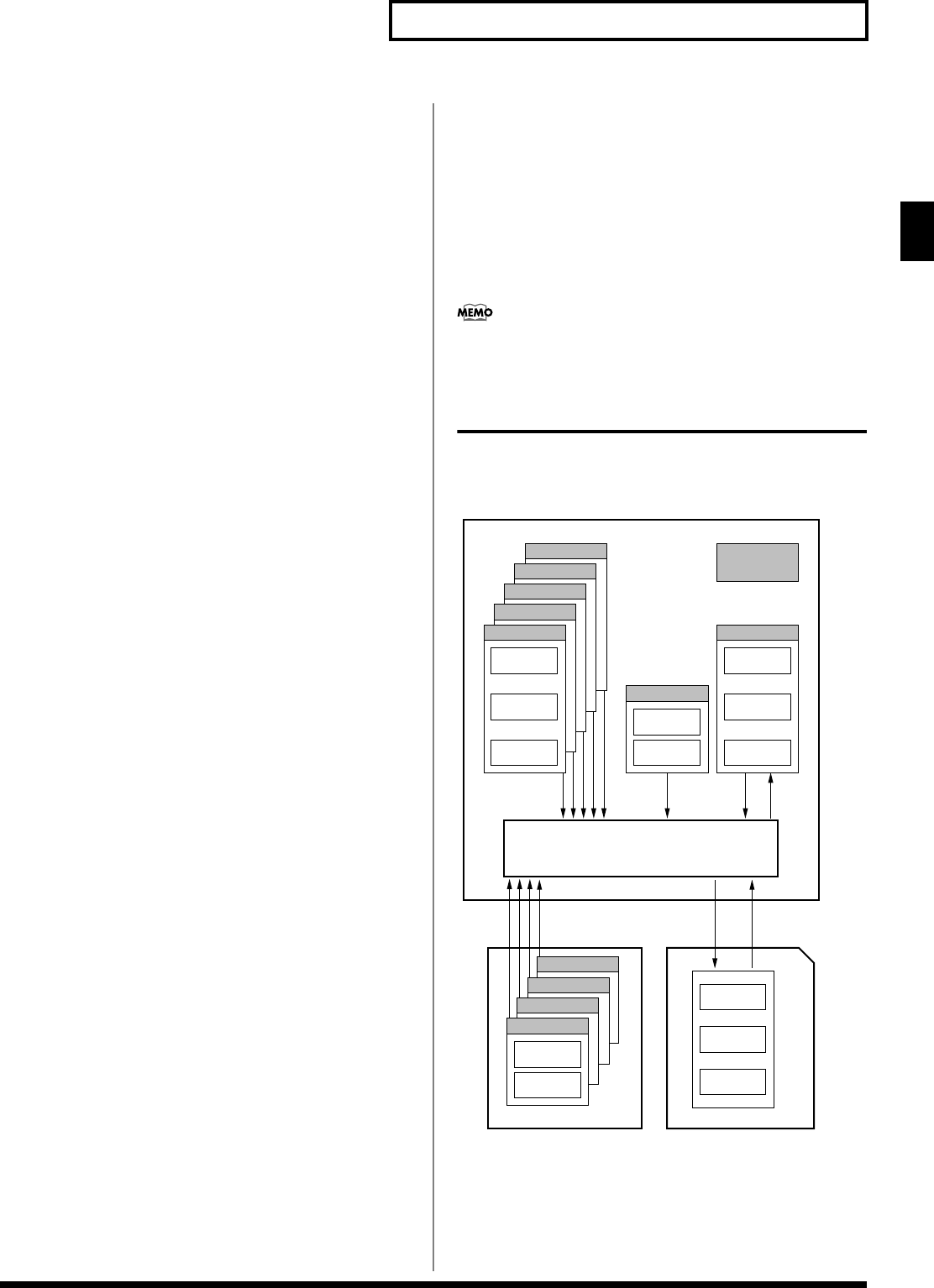
19
Overview of the Fantom-S
Overview of the Fantom-S
Part
On the Fantom-S, a “part” is something to which you assign a patch
or rhythm set. Patch mode has two parts, the Pad part and the
Keyboard part, and you can assign a patch or rhythm set to each of
these parts. In Performance mode, each performance has sixteen
parts, and you can assign a patch or rhythm set to each part.
About Simultaneous Polyphony
The Fantom-S can play a maximum of 64 sounds simultaneously.
The following paragraphs discuss what this means, and what will
happen when more than 64 simultaneous voices are requested from
the Fantom-S.
Calculating the Number of Voices
Being Used
The Fantom-S is able to play up to 64 notes simultaneously. The
polyphony, or the number of voices (sounds) does not refer only to
the number of sounds actually being played, but changes according
to the number of tones used in the patches, and the number of
Waves used in the tones. The following method is used to calculate
the number of sounds used for one patch being played.
(Number of Sounds Being Played) x (Number of tones Used by
Patches Being Played) x (Number of Waves Used in the tones)
For example, with a patch combining four tones, each of which uses
two Waves, the actual number of sounds being played comes to 8.
Also, when playing in Performance mode, the number of sounds for
each part is counted to obtain the total number of sounds for all
parts.
How a Patch Sounds
When the Fantom-S is requested to play more than 64 voices
simultaneously, currently sounding notes will be turned off to make
room for newly requested notes. The note with the lowest priority
will be turned off first. The order of priority is determined by the
Voice Priority setting (p. 43).
Voice Priority can be set either to “LAST” or “LOUDEST.” When
“LAST” is selected, a newly requested note that exceeds the 64 voice
limit will cause the first-played of the currently sounding notes to be
turned off. When “LOUDEST” is selected, the quietest of the
currently sounding notes will be turned off. Usually, “LAST” is
selected.
Note Priority in Performance Mode
Since Performance mode is usually used to play an ensemble consisting
of several patches, it is important to decide which parts take priority.
Priority is specified by the Voice Reserve settings (p. 88). When a note
within a patch needs to be turned off to make room for a new note, the
Voice Priority setting of the patch will apply (p. 43).
Voice Reserve
The Fantom-S has a Voice Reserve function that lets you reserve a
minimum number of notes that will always be available for each
part. For example if Voice Reserve is set to “10” for part 16, part 16
will always have 10 notes of sound-producing capacity available to it
even if a total of more than 64 notes (total for all parts) are being
requested. When you make Voice Reserve settings, you need to take
into account the number of notes you want to play on each part as
well as the number of tones used by the selected patch (p. 88).
It is not possible to make Voice Reserve settings that would
cause the total of all parts to be greater than 64 voices.
About Memory
Patch and performance settings are stored in what is referred to as
memory. There are three kind of memory: temporary, rewritable,
and non-rewritable.
fig.01-06.e
EXP C Slot
EXP B Slot
Preset E (PR-E)
Fantom
Preset D (PR-D)
Preset C (PR-C)
Preset B (PR-B)
Preset A (PR-A)
Temporary Area
Rhythm Set
32
Patch
128
Performance
64
GM (GM2)
User (USER)
System
Rhythm Set
32
Patch
256
Performance
64
Wave Expansion Board Memory Card
Patch
256
Rhythm Set
32
Performance
64
* 1
Patch
256
Rhythm Set
9
EXP A Slot
Patch
Rhythm Set
* 1 Only in PR-A (PRST)
* 2 The selected Patches/Rhythm Sets cannot be changed.
Select Select Write
* 2
WriteSelectSelect
EXP D Slot
Select
* 1
Reference_e.book 19 ページ 2003年7月14日 月曜日 午後3時25分


















